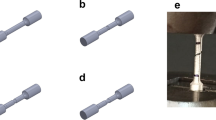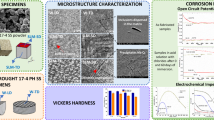Abstract
A novel approach is proposed to determine a physically meaningful length-scale parameter for the phase-field modeling of macroscale fracture in metal–ceramic composites on an example of chromium–alumina composite fabricated by powder metallurgy. The approach is based on the fractography analysis by the scanning electron microscopy (SEM) with the aim to measure the process zone size and use that value as the length-scale parameter in the phase-field modeling. Mode I and mixed-mode I/II fracture tests are conducted on Cr–Al2O3 composites at different reinforcement volume fractions and particle sizes using single-edge notched beams under four-point bending. The fracture surfaces are analyzed in detail by SEM to determine the size of the process zone where the microscale nonlinear fracture events occur. The model adequately approximates the experimentally measured fracture toughness and the fracture loads. It is shown that the model prediction of the crack initiation direction under the mixed-mode loading is in agreement with the experiments and the generalized maximum tangential stress criterion. These outcomes justify using the process zone size as the scale parameter in the phase-field modeling of macroscale fracture in chromium–alumina and similar metal–ceramic composites.























Similar content being viewed by others
References
M. Rosso: J. Mater. Process. Technol., 2006, vol. 175, pp. 364–75.
M. Finot, Y.L. Shen, A. Needleman, and S. Suresh: Metall. Mater. Trans. A, 1994, vol. 25A, pp. 2403–20.
Y.L. Shen, A. Needleman, and S. Suresh: Metall. Mater. Trans. A, 1994, vol. 25A, pp. 839–50.
J. Zygmuntowicz, H. Winkler, M. Wachowski, P. Piotrkiewicz, and W. Kaszuwara: Metall. Mater. Trans. A, 2021, vol. 52A, pp. 3628–46.
J. Maj, W. Węglewski, K. Bochenek, Ł Rogal, S. Woźniacka, and M. Basista: Metall. Mater. Trans. A, 2021, vol. 52A, pp. 4727–36.
A.B. Pandey, B.S. Majumdar, and D.B. Miracle: Metall. Mater. Trans. A, 2000, vol. 31A, pp. 921–36.
S.G. Song, N. Shi, G.T. Gray, and J.A. Roberts: Metall. Mater. Trans. A, 1996, vol. 27A, pp. 3739–46.
P. Agrawal and C.T. Sun: Compos. Sci. Technol., 2004, vol. 64, pp. 1167–78.
X.J. Wang, K. Wu, W.X. Huang, H.F. Zhang, M.Y. Zheng, and D.L. Peng: Compos. Sci. Technol., 2007, vol. 67, pp. 2253–60.
Q. Wu, W. Xu, and L. Zhang: Composites B, 2019, vol. 163, pp. 384–92.
W. Węglewski, P. Pitchai, K. Bochenek, G. Bolzon, R. Konetschnik, B. Sartory, R. Ebner, D. Kiener, and M. Basista: Metall. Mater. Trans. A, 2020, vol. 51A, pp. 2377–90.
A. Ayyar and N. Chawla: Compos. Sci. Technol., 2006, vol. 66, pp. 1980–94.
A. Ayyar and N. Chawla: Acta Mater., 2007, vol. 55, pp. 6064–73.
M. Li, S. Ghosh, O. Richmond, H. Weiland, and T.N. Rouns: Mater. Sci. Eng. A, 1999, vol. 266, pp. 221–40.
J. Llorca, A. Needleman, and S. Suresh: Acta Metall. Mater., 1991, vol. 39, pp. 2317–35.
C. Miehe, F. Welschinger, and M. Hofacker: Int. J. Numer. Methods Eng., 2010, vol. 83, pp. 1273–1311.
C. Miehe, M. Hofacker, and F. Welschinger: Comput. Methods Appl. Mech. Eng., 2010, vol. 199, pp. 2765–78.
S.N. Hirshikesh, R.K. Annabattula, and E. Martínez-Pañeda: Composites B, 2019, vol. 169, pp. 239–48.
G. Molnár, A. Gravouil, R. Seghir, and J. Réthoré: Comput. Methods Appl. Mech. Eng., 2020, vol. 365, p. 113004.
Y. Feng, Q. Wang, D. Wu, Z. Luo, X. Chen, T. Zhang, and W. Gao: Int. J. Eng. Sci., 2021, vol. 169, p. 103587.
S. Goswami, C. Anitescu, S. Chakraborty, and T. Rabczuk: Theor. Appl. Fract. Mech., 2020, vol. 106, p. 102447.
T.-T. Nguyen, J. Yvonnet, D. Waldmann, and Q.-C. He: Eng. Fract. Mech., 2019, vol. 218, p. 106574.
T.T. Nguyen, J. Yvonnet, Q.Z. Zhu, M. Bornert, and C. Chateau: Comput. Methods Appl. Mech. Eng., 2016, vol. 312, pp. 567–95.
Y. Chen, D. Vasiukov, L. Gélébart, and C.H. Park: Comput. Methods Appl. Mech. Eng., 2019, vol. 349, pp. 167–90.
S.B. Biner and S.Y. Hu: Acta Mater., 2009, vol. 57, pp. 2088–97.
G. Molnár, A. Doitrand, R. Estevez, and A. Gravouil: Theor. Appl. Fract. Mech., 2020, vol. 109, p. 102736.
T.T. Nguyen, J. Yvonnet, M. Bornert, C. Chateau, K. Sab, R. Romani, and R. Le Roy: Int. J. Fract., 2016, vol. 197, pp. 213–26.
E. Tanné, T. Li, B. Bourdin, J.J. Marigo, and C. Maurini: J. Mech. Phys. Solids, 2018, vol. 110, pp. 80–99.
P.J. Loew, B. Peters, and L.A.A. Beex: J. Mech. Phys. Solids, 2019, vol. 127, pp. 266–94.
ISO 23146:2012, Fine Ceramics (Advanced Ceramics, Advanced Technical Ceramics)—Test Methods for Fracture Toughness of Monolithic Ceramics—Single-Edge V-Notch Beam (SEVNB) Method.
W. Węglewski, M. Krajewski, K. Bochenek, P. Denis, A. Wysmołek, and M. Basista: Mater. Sci. Eng. A, 2019, vol. 762, p. 138111.
W. Węglewski, M. Basista, M. Chmielewski, and K. Pietrzak: Composites B, 2012, vol. 43, pp. 255–64.
A. Rabiei, L. Vendra, and T. Kishi: Composites A, 2008, vol. 39, pp. 294–300.
H. Prielipp, M. Knechtel, N. Claussen, S.K. Streiffer, H. Müllejans, M. Rühle, and J. Rödel: Mater. Sci. Eng. A, 1995, vol. 197, pp. 19–30.
J. Ulloa, P. Rodríguez, C. Samaniego, and E. Samaniego: Undergr. Space, 2019, vol. 4, pp. 10–21.
C. Kuhn, A. Schlüter, and R. Müller: Comput. Mater. Sci., 2015, vol. 108, pp. 374–84.
J.-Y. Wu: J. Mech. Phys. Solids, 2017, vol. 103, pp. 72–99.
P.K. Kristensen and E. Martínez-Pañeda: Theor. Appl. Fract. Mech., 2020, vol. 107, p. 102446.
T. Wick: SIAM J. Sci. Comput., 2017, vol. 39, pp. B589–8617.
T. Gerasimov and L. De Lorenzis: Comput. Methods Appl. Mech. Eng., 2016, vol. 312, pp. 276–303.
T. Wick: Comput. Methods Appl. Mech. Eng., 2017, vol. 325, pp. 577–611.
B. Bourdin, G.A. Francfort, and J.J. Marigo: J. Mech. Phys. Solids, 2000, vol. 48, pp. 797–826.
G. Molnár and A. Gravouil: Finite Elem. Anal. Des., 2017, vol. 130, pp. 27–38.
R. de Borst and C.V. Verhoosel: Comput. Methods Appl. Mech. Eng., 2016, vol. 312, pp. 78–94.
ISO 14704:2016, Fine Ceramics (Advanced Ceramics, Advanced Technical Ceramics)—Test Method for Flexural Strength of Monolithic Ceramics at Room Temperature.
S.H. Chen and T.C. Wang: Acta Mech., 2002, vol. 157, pp. 113–27.
M.G.D. Geers, R. de Borst, W.A.M. Brekelmans, and R.H.J. Peerlings: Int. J. Solids Struct., 1999, vol. 36, pp. 2557–83.
H. Darban, M. Haghpanahi, and A. Assadi: Comput. Mater. Sci., 2011, vol. 50, pp. 1667–74.
D.J. Smith, M.R. Ayatollahi, and M.J. Pavier: Fatigue Fract. Eng. Mater. Struct., 2001, vol. 24, pp. 137–50.
Funding
This research was supported by the National Science Centre (Poland) Grant No. UMO-2014/15/B/ST8/04314.
Conflict of interest
The authors declare that they have no conflict of interest.
Author information
Authors and Affiliations
Corresponding author
Additional information
Publisher's Note
Springer Nature remains neutral with regard to jurisdictional claims in published maps and institutional affiliations.
Appendix: Spectral Decomposition
Appendix: Spectral Decomposition
The strain tensor is decomposed into positive (tensile) and negative (compressive) parts:
The positive and negative contributions are defined through the spectral decomposition of the strain tensor
with \({\left\langle X \right\rangle_\pm } = \left( {X \pm \left| X \right|} \right)/2\). The \({\varepsilon^i}\) and ni for i = 1,…,\(\delta \) are the principal strains and their directions (\(\delta\) = 2, or 3 for two- or three-dimensional problems).
The positive and negative contributions into the energy density in Eq. [4] are defined as:
where λ and µ are the Lame coefficients and \({\text{tr}}\left[ X \right]\) is the trace of X.
Rights and permissions
About this article
Cite this article
Darban, H., Bochenek, K., Węglewski, W. et al. Experimental Determination of the Length-Scale Parameter for the Phase-Field Modeling of Macroscale Fracture in Cr–Al2O3 Composites Fabricated by Powder Metallurgy. Metall Mater Trans A 53, 2300–2322 (2022). https://doi.org/10.1007/s11661-022-06677-3
Received:
Accepted:
Published:
Issue Date:
DOI: https://doi.org/10.1007/s11661-022-06677-3




